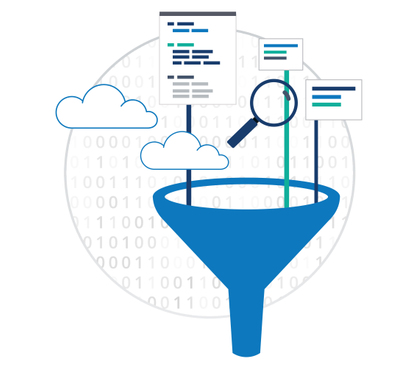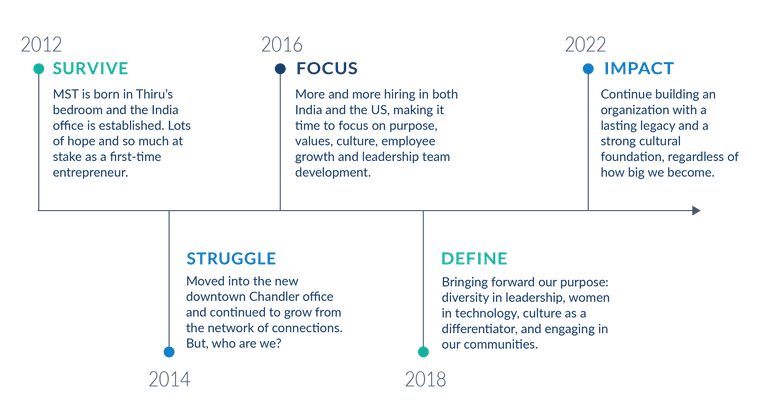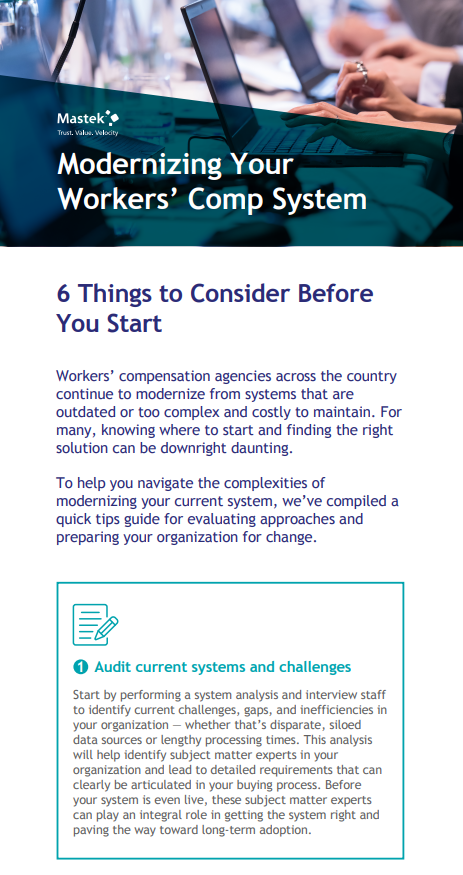Main Menu
WORKERS' COMPENSATION SOLUTIONS
Leverage our industry knowledge and implementation expertise to operate smarter, achieve more, and improve services.
As the workers' comp industry evolves, evolve with it
From rising constituent expectations to changing workforce demographics and increased complexity of claims to changes in statute, workers’ compensation agencies are facing an ever-evolving industry. As many look to secure better futures by embracing data and ecosystem collaboration, they are faced with the challenge of operating from complex and outdated legacy systems.
But that doesn’t need to be the case. We help bring workers’ compensation agency modernization to life, efficiently and effectively, by harnessing the right digital technologies. Innovating where the industry and technology intersect, we bring expertise to resolve the biggest challenges facing workers’ compensation agencies today.
Whatever your vision, we enable you to turn your ideas for an efficient, streamlined, constituent-focus agency into reality.
Turn challenges into opportunities
How can your workers’ compensation agency transform today’s challenges into opportunities to become constituent focused and drive efficiency and excellence? MST Solutions sees three areas of focus when transforming your workers’ compensation agency:
Claims processing and adjuducation
Compliance
Collaboration
Claims processing and adjuducation
Workers’ compensation claim intake and matching processes are the most critical steps in the claims process. The claimant, the employer, and other involved stakeholders must act quickly and efficiently to meet deadlines and reduce errors.
The problem is, many agencies are using outdated technology requiring multiple manual, time-consuming steps to process a single document. Often, this translates to employees spending a great deal of time tracking down and communicating the status of the claim, or even attempting to decipher and match fields with handwritten inputs.
A modern, integrated platform can reduce errors of manual input and can also improve overall claims matching. MST has implemented solutions that resulted in roughly a 30% improvement on claims match. Additionally, paper forms can easily be converted to web forms, enabling claimants, attorneys, insurance carriers, employers, and other involved stakeholders to conduct business through an online authenticated system. This makes data easily available and accessible to those who need it when they need it.

Compliance
Legacy systems and outdated processes rely heavily on reading and interpreting handwritten forms, manually entering data, and physically timestamping documents. In an industry focused heavily on time-sensitive and personal information, compliance is key. Unfortunately, the aforementioned processes are often susceptible to human error. These delays and errors are critical when claims processing is required within a certain timeframe.
Using an updated, configurable platform allows organizations to digitally process, document, and approve files digitally, reducing the reliance on manual processes and interpretation. These systems also create automated, digital timestamps to ensure dates are tracked and required timeframes are met, which reduces processing times and decreases administrative work.

Collaboration
Workers’ compensation processing involves a wide range of departments and groups, including claims, administrative law judges (ALJ), special fund, compliance, insurance, wage, and ombudsman groups. Additionally, community users including workers or claimants, attorneys, employer representatives, carrier representatives and adjusters, and third-party administrator representatives/adjusters can be involved in the process.
The problem for many agencies is legacy systems often don’t have the capabilities to integrate data across the range of stakeholders involved. These outdated systems limit automation, collaboration, and interoperability, creating breakdowns in communication, inefficiencies, and errors.
Implementing a collaborative, integrated platform allows agencies to connect a number of applications, bringing everything from risk and compliance to authorization and reimbursement to approvals under one single source of truth.
Wondering where to start?
Download our quick tip sheet on what to consider before modernizing your workers’ compensation system.

See how the Industrial Commission of Arizona reduced manual steps for inbound documents from 7 human touches to 0 for all electronically received documents.




